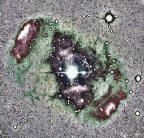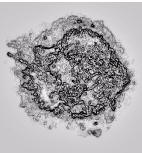Evolutions of galaxies, type I and Type II supernova, hypernova and gamma-ray burst sources
...In the conventional theory of star formation, the condensation of gas cloud creates the collapse of the clouds as the result of gravitational attraction. The collapse heats up the core, which becomes the sites of star births. After the star is born the stellar wind creates a cavity around the new born star and expel the remaining clouds, which are not accreted by the star. After this process of birth from a collapsed cloud, the stars evolve according to the nuclear reactions taking place inside the core. The stars burn as long the hydrogen fuel is not used up. When all hydrogen are burnt out, it collapses again and ignite the helium burning in the core and turn into extremely hot helium stars. This heat creates a nebula hundreds of times larger in size around the star and then passes into a dying phase. It is believed that most stars in the sky will one day face such gradual death at the end of their life cycles. However, some stars will face more dramatic ends. These stars are the larger ones, where the fuel burning may occur very fast causing a very quick evolution. As a price of such a fast growth, they end in explosive deaths, which create fiery scenes. They have been called supernovae. These supernovae bursts are believed to create shocks in the surrounding gas clouds, and set the process of condensation of the clouds around it, where new stars may be born.
 ....The
star formation model, in the new theory, differs much from this conventional
view. First, the clouds do not condensate due to gravitational collapse
initiated by he shocks of supernovae. The stars are born inside cloudlets which
are expelled from the shells of larger structures, where bigger stars or stellar
clusters take shapes as filamentary knots. As the knots tighten while they
evolve through the turbulent medium, cloudlets are hurled outward. As the
outflow strikes the surrounding medium, it experiences shock compression and the
seeds of stellar structures are created. Thus smaller and smaller structures,
may form while triggered by the ejections from larger structures. The birth of a
structure at any particular scale have consequences in generating a series of
births of smaller structures, which in turn set the conditions of birth of even
smaller structures in the next scale. It is the shock, caused by the birth of a
structure at a large scale, which creates the conditions of births of the
smaller objects. It is not the gravitational attraction which is the driving
force behind the star births. The dynamics of stellar births are driven
primarily by magneto-hydrodynamic turbulent flows, which animate every corners
of the universe.
....The
star formation model, in the new theory, differs much from this conventional
view. First, the clouds do not condensate due to gravitational collapse
initiated by he shocks of supernovae. The stars are born inside cloudlets which
are expelled from the shells of larger structures, where bigger stars or stellar
clusters take shapes as filamentary knots. As the knots tighten while they
evolve through the turbulent medium, cloudlets are hurled outward. As the
outflow strikes the surrounding medium, it experiences shock compression and the
seeds of stellar structures are created. Thus smaller and smaller structures,
may form while triggered by the ejections from larger structures. The birth of a
structure at any particular scale have consequences in generating a series of
births of smaller structures, which in turn set the conditions of birth of even
smaller structures in the next scale. It is the shock, caused by the birth of a
structure at a large scale, which creates the conditions of births of the
smaller objects. It is not the gravitational attraction which is the driving
force behind the star births. The dynamics of stellar births are driven
primarily by magneto-hydrodynamic turbulent flows, which animate every corners
of the universe.
..The type II supernovae are associated with jets from the centre, and do not
indicate the phenomenon of core collapse. Instead, they show typical structures
observed in many planetary nebulae, where the knots, binding the shells, break
and fly away as jets, while releasing the outer shells to expand. In the case of
the Crab, this breakdown has occurred deeper within the core, while the outer
shells still remain bound. The jet, which has em erged
from the centre, has disrupted the symmetric building of shells lying on the
opposite sides, and thus forced its way through the stellar gas and dust, while
pushing them away from the centre. In the case of Cassiopeia A the jet is not so
forceful, and disruptive as in the case of Crab supernova. The same is true for
the SN 1987A, where the jets ply through the inner structure.
erged
from the centre, has disrupted the symmetric building of shells lying on the
opposite sides, and thus forced its way through the stellar gas and dust, while
pushing them away from the centre. In the case of Cassiopeia A the jet is not so
forceful, and disruptive as in the case of Crab supernova. The same is true for
the SN 1987A, where the jets ply through the inner structure.
The case for Type I supernova is different. In the new theory they appear as the ejecta from the dying stars. They could be the knot structures, which break away from the stellar system in two opposite directions. Once freed from the knots, the stellar shells expand, which one may see in many SNRs. These ejected knots can be found far away from the remnant where the dual shells move away from each other and expand as if caused by an explosion. These remnants may also show characteristics of the Type I supernovae.
...Supernovae have also been found to be associated with the gamma-ray bursts, which the gamma-ray satellites have started detecting on the average of one everyday since the time of their launching in the beginning of 1990s. The sources of these sudden flares in gamma-rays, occurring for a time varying from milliseconds to seconds, remained a mystery until the optical counterparts were observed. These optical counterparts indicated that the origin of the gamma-ray burst sources were in galaxies outside the Milky Way. The regions where these gamma-ray bursts occur are often associated with the regions dominated by high red-shift galaxies, where stars are taking births. However, the origin of such enormous gamma-explosions remained unclear until the discovery that the Gamma-ray burst GRB980425, which occurred on 25 April 1998 (naming of a GRB indicates the date of observation). It was actually associated with a supernova taking place in a nearby galaxy. The supernova associated with this gamma-ray burst, turned out to be a Type Ic. This supernova was more powerful than the usual ones and were believed to be the results of the collapse of hypermassive stars.
 I
do not share this interpretation and instead believe that these flares are not
associated with core collapse.The gamma-ray flares are generated by the ejecta
from the centres of a star forming region. In the case of the GRB 980425, it
occurs at the centre of a star-forming region existing beyond the spiral arm of
a young star-forming galaxy, which is under evolution. The bursts occurred at
the centre of a stellar cluster under formation. An ejecta can be seen to be
moving from the position of the gamma-ray burst. The optical flares occur when
this ejecta from the centre strikes the dense shells, where the stars are being
formed. Like the birth of star cluster, such ejecta may also occur while a large
single star is born. The ejecta may partially, or totally disrupt the double
shell structures, common to all cosmic bodies. When one observes this disruption
in a star it is interpreted as supernova of Type II. The rapid speed of
formation destabilize the usual dynamics of the hierarchical shell formations by
the mechanism of ejections from the centre. In the GRB 980425, the ejecta has
caused minor disruption and not brought a catastrophic change in its structure.
In more catastrophic events, the ejecta will disrupt the mechanism by which the
cosmic structures take their shapes and evolve. (The image shows ejections
from GRB 030329)
I
do not share this interpretation and instead believe that these flares are not
associated with core collapse.The gamma-ray flares are generated by the ejecta
from the centres of a star forming region. In the case of the GRB 980425, it
occurs at the centre of a star-forming region existing beyond the spiral arm of
a young star-forming galaxy, which is under evolution. The bursts occurred at
the centre of a stellar cluster under formation. An ejecta can be seen to be
moving from the position of the gamma-ray burst. The optical flares occur when
this ejecta from the centre strikes the dense shells, where the stars are being
formed. Like the birth of star cluster, such ejecta may also occur while a large
single star is born. The ejecta may partially, or totally disrupt the double
shell structures, common to all cosmic bodies. When one observes this disruption
in a star it is interpreted as supernova of Type II. The rapid speed of
formation destabilize the usual dynamics of the hierarchical shell formations by
the mechanism of ejections from the centre. In the GRB 980425, the ejecta has
caused minor disruption and not brought a catastrophic change in its structure.
In more catastrophic events, the ejecta will disrupt the mechanism by which the
cosmic structures take their shapes and evolve. (The image shows ejections
from GRB 030329)
Read more ....
Copyright ©2006 Anup Rej, All Rights Reserved.